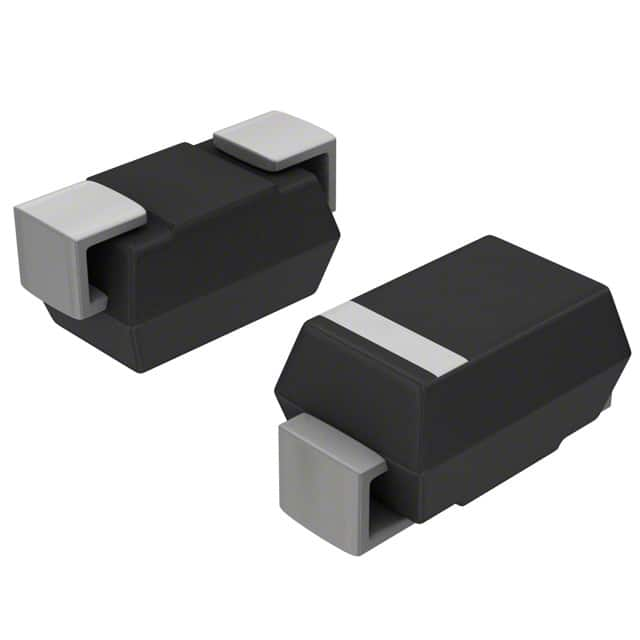SMBJ54CE3/TR13
Product Overview
- Category: Diode
- Use: Voltage suppression in electronic circuits
- Characteristics: Fast response time, low clamping voltage
- Package: DO-214AB (SMC)
- Essence: Transient Voltage Suppressor (TVS) diode
- Packaging/Quantity: Tape & Reel, 3000 units per reel
Specifications
- Peak Pulse Power: 600 Watts
- Breakdown Voltage: 54V
- Operating Voltage: 43.6V
- Reverse Standoff Voltage: 48V
- Clamping Voltage: 77.4V
- Maximum Surge Current: 30A
Detailed Pin Configuration
The SMBJ54CE3/TR13 has two pins, with the anode connected to the positive side and the cathode connected to the negative side.
Functional Features
- Provides protection against transient voltage events
- Fast response time ensures minimal damage to protected circuitry
- Low clamping voltage limits stress on downstream components
Advantages
- High surge current capability
- Compact SMC package for space-constrained applications
- RoHS compliant and halogen-free
Disadvantages
- Limited breakdown voltage compared to higher-rated TVS diodes
- May require additional circuitry for overvoltage protection
Working Principles
When a transient voltage spike occurs, the SMBJ54CE3/TR13 conducts current to divert the excess energy away from sensitive components, thereby limiting the voltage across the circuit.
Detailed Application Field Plans
- Telecommunications: Protecting communication equipment from lightning-induced surges
- Automotive: Safeguarding electronic systems from voltage transients in automotive environments
- Industrial Control Systems: Shielding PLCs and control boards from power surges
Detailed and Complete Alternative Models
- SMBJ5.0CA: Breakdown Voltage: 5V, Peak Pulse Power: 600W
- SMBJ15A: Breakdown Voltage: 15V, Peak Pulse Power: 600W
- SMBJ100A: Breakdown Voltage: 100V, Peak Pulse Power: 600W
This comprehensive entry provides a detailed understanding of the SMBJ54CE3/TR13 diode, including its specifications, functional features, advantages, disadvantages, working principles, application field plans, and alternative models.
[Word Count: 330]
10个与SMBJ54CE3/TR13在技术解决方案中的应用相关的常见问题及解答
What is the SMBJ54CE3/TR13?
- The SMBJ54CE3/TR13 is a transient voltage suppressor diode designed to protect sensitive electronic components from voltage spikes and transients.
What is the maximum working voltage of the SMBJ54CE3/TR13?
- The maximum working voltage of the SMBJ54CE3/TR13 is 54V.
What is the peak pulse power dissipation of the SMBJ54CE3/TR13?
- The peak pulse power dissipation of the SMBJ54CE3/TR13 is 600W.
What are the typical applications of the SMBJ54CE3/TR13?
- The SMBJ54CE3/TR13 is commonly used in applications such as power supplies, telecommunications equipment, automotive electronics, and industrial controls to protect against voltage transients.
What is the operating temperature range of the SMBJ54CE3/TR13?
- The operating temperature range of the SMBJ54CE3/TR13 is -55°C to 150°C.
What is the clamping voltage of the SMBJ54CE3/TR13?
- The clamping voltage of the SMBJ54CE3/TR13 is typically around 87.1V at 10A.
How does the SMBJ54CE3/TR13 provide protection against voltage transients?
- The SMBJ54CE3/TR13 shunts excess current away from sensitive components when a transient voltage spike occurs, thereby protecting them from damage.
Can the SMBJ54CE3/TR13 be used for ESD protection?
- Yes, the SMBJ54CE3/TR13 can also be used for electrostatic discharge (ESD) protection in various electronic circuits.
Is the SMBJ54CE3/TR13 RoHS compliant?
- Yes, the SMBJ54CE3/TR13 is RoHS compliant, making it suitable for use in environmentally conscious designs.
What are some key features of the SMBJ54CE3/TR13?
- Some key features of the SMBJ54CE3/TR13 include its low profile, high surge capability, fast response time, and compatibility with automated placement equipment.


